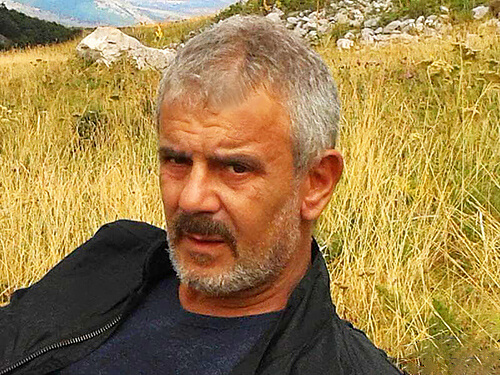Giorgio Di Maio (1963, Naples) begins to take photos during his Architectural studies (1990),where he understood the strength of the photography as a mean to extrapolate from the reality a piece of the reality itself, independent in the shape and in the substance having a own narrative meaning. The expositive activity (since 1992) and the professional one (since 1993) went forward together, and every kind of restructuring activity is an opportunity for linguistic research. In 2003 he held a Master in "Fotografia dello spettacolo" by Silvia Lelli, At European Institute of Design in Milano, that introduced him to a deep research into the American Photography. Between 20017 and 2010, in Basilicata, he developed the series "Paesaggi lucani" and tried in the same period the digital photo machine. In Di Maio, then, woke up his environmental soul that bring the artist in 2011 to a new exhibition "Non è Napoli" dedicated to his own city and its beauty during the rubbish scandal. Since 2013 he slowed down the architect profession starting to study philosophy as theorical support to the practical photography, going from Naples to Milan very often, and vice versa. Then he creates" Armonia nascosta", from his studies, that is written with a specific modus operandi, aware of his reasons and purpose. Starting form Heraclitus, the Hidden Harmony show the transmigration of the mystical and philosophical roots of Paul Klee e Vassilij Kandinskij's abstract art til the photography, transforming it into a growth process both spiritual and social of a man, who goes through the evidence of the visual data looking for the Hidden Harmony as it appears today. Some projects "I sentieri dell'acqua e Chiaroscuro" (2013-2014), "Feminine, Photokina" (2016), "Cristianesimo Arte e Paganesimo" (2017), "Correspondances" (2018), "Milano in Armonia" (2018), "Il mare di Leopardi (2020), always continuing his studies of the immaterial in the material world. In 2017 he published his Photographic-philosophic web site of his research, that will be considered by different international photographic magazines. Then he started an intense exhibitions period, among public exhibition and festivals, having so many positive feedbacks from the public but also from the sector critical. In 2019, the Prof. Guido Ferraro, full professor of "Semiotica e Teoria della narrazione" at Torino's University, named Di Maio's research with those by Franco Fontana, Luigi Ghirri and Mario Giacomelli. Giorgio di Maio goes from a city to another, looking for the Hidden Harmony in nowadays reality.
About Hidden Harmony
The project that I would represent is the mystical and philosophical roots of Abstract Art transmigration into the Photography.
The Art as knowledge tool to understand the sense. Going over the phenomenon, the appearances, searching for the law that create each event, for everyone also individual or being part of a whole.
Basically there is the rejection of materialism, the faith in progress and particularly the faith in the spiritual progress of the men helped from the artist which "has in himself a mysterious visionary force....to see and to show".
The photographer artist isn't a perfected camera who think that the knowledge and the experiences are only a replica of reality, who limit to reproduction of the exteriority, closed from the barriers of the phenomenon, but he know and must to express an ethical content which he gets from the sensitive data.
The equilibrium that comes out from the tens and integration of differences, where the opposites converge completing themselves and the materiality falls to leave space to the spiritual presence, transform every shot in a travel through the space-time instances, instead of being the static representation of the place.
In the Photography the language remain the same, using shape and color like the musical notes that touch the soul when you press a key and the human spirit vibrate.
The research is the Harmony: to identify in the reality different elements in contrast with each other but in a unitary composition to create a mutual stimulating of the sense of balance and rest. The Peace.
The expressionism of Der Blaue Reiter started in the of age of the new spirituality. Instead the wars and the extermination camps comes. It doesn't mean that the materialism has won but only a wrong idea of the temporal date. We don't know how much time need to achieve the spiritual progress of the humanity, maybe thousands of years or more.
The important thing is that each era made a new step in right direction and in the contemporary era the Photography could be the most powerful means to give a contribution in this way.
